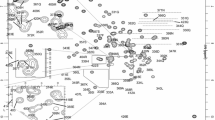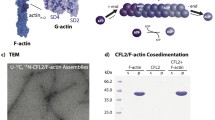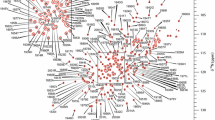Abstract
α-Catenin is a filamentous actin (F-actin) binding protein that links the classical cadherin–catenin complex to the actin cytoskeleton at adherens junctions (AJs). Its C-terminal F-actin binding domain is required for regulating the dynamic interaction between AJs and the actin cytoskeleton during tissue development. Thus, obtaining the molecular details of this interaction is a crucial step towards understanding how α-catenin plays critical roles in biological processes, such as morphogenesis, cell polarity, wound healing and tissue maintenance. Here we report the backbone atom (1HN, 15N, 13Cα, 13Cβ and 13C′) resonance assignments of the C-terminal F-actin binding domain of αN-catenin.


Similar content being viewed by others
References
Borghi N, Sorokina M, Shcherbakova OG, Weis WI, Pruitt BL, Nelson WJ, Dunn AR (2012) E-cadherin is under constitutive actomyosin-generated tension that is increased at cell–cell contacts upon externally applied stretch. Proc Natl Acad Sci USA 109:12568–12573. doi:10.1073/pnas.1204390109
Buckley CD et al (2014) Cell adhesion. The minimal cadherin–catenin complex binds to actin filaments under force. Science 346:1254211. doi:10.1126/science.1254211
Delaglio F, Grzesiek S, Vuister GW, Zhu G, Pfeifer J, Bax A (1995) NMRPipe: a multidimensional spectral processing system based on UNIX pipes. J Biomol NMR 6:277–293
Desai R, Sarpal R, Ishiyama N, Pellikka M, Ikura M, Tepass U (2013) Monomeric alpha-catenin links cadherin to the actin cytoskeleton. Nat Cell Biol 15:261–273. doi:10.1038/ncb2685
Ishiyama N et al (2013) An autoinhibited structure of alpha-catenin and its implications for vinculin recruitment to adherens junctions. J Biol Chem 288:15913–15925. doi:10.1074/jbc.M113.453928
Johnson BA, Blevins RA (1994) NMR View: a computer program for the visualization and analysis of NMR data. J Biomol NMR 4:603–614. doi:10.1007/BF00404272
Kobielak A, Fuchs E (2004) Alpha-catenin: at the junction of intercellular adhesion and actin dynamics. Nat Rev Mol Cell Biol 5:614–625. doi:10.1038/nrm1433
le Duc Q, Shi Q, Blonk I, Sonnenberg A, Wang N, Leckband D, de Rooij J (2010) Vinculin potentiates E-cadherin mechanosensing and is recruited to actin-anchored sites within adherens junctions in a myosin II-dependent manner. J Cell Biol 189:1107–1115. doi:10.1083/jcb.201001149
Pappas DJ, Rimm DL (2006) Direct interaction of the C-terminal domain of alpha-catenin and F-actin is necessary for stabilized cell–cell adhesion. Cell Commun Adhes 13:151–170. doi:10.1080/15419060600726142
Pokutta S, Drees F, Takai Y, Nelson WJ, Weis WI (2002) Biochemical and structural definition of the lafadin- and actin-binding sites of alpha-catenin. J Biol Chem 277:18868–18874. doi:10.1074/jbc.M201463200
Pokutta S, Choi HJ, Ahlsen G, Hansen SD, Weis WI (2014) Structural and thermodynamic characterization of cadherin.beta–catenin.alpha-catenin complex formation. J Biol Chem 289:13589–13601. doi:10.1074/jbc.M114.554709
Rangarajan ES, Izard T (2013) Dimer asymmetry defines alpha-catenin interactions. Nat Struct Mol Biol 20:188–193. doi:10.1038/nsmb.2479
Shen Y, Bax A (2013) Protein backbone and sidechain torsion angles predicted from NMR chemical shifts using artificial neural networks. J Biomol NMR 56:227–241. doi:10.1007/s10858-013-9741-y
Uchida N, Shimamura K, Miyatani S, Copeland NG, Gilbert DJ, Jenkins NA, Takeichi M (1994) Mouse alpha N-catenin: two isoforms, specific expression in the nervous system, and chromosomal localization of the gene. Dev Biol 163:75–85. doi:10.1006/dbio.1994.1124
Yao M et al (2014) Force-dependent conformational switch of alpha-catenin controls vinculin binding. Nat Commun 5:4525. doi:10.1038/ncomms5525
Yonemura S, Wada Y, Watanabe T, Nagafuchi A, Shibata M (2010) alpha-Catenin as a tension transducer that induces adherens junction development. Nat Cell Biol 12:533–542. doi:10.1038/ncb2055
Acknowledgments
This work was supported by CIHR Grant (MOP 130267) to M.I. The 800 MHz NMR spectrometer used in this study was funded by the Canada Foundation for Innovation. M.I. holds Canada Research Chair in cancer structural biology.
Author information
Authors and Affiliations
Corresponding author
Ethics declarations
This article does not contain any studies with human or animal subjects.
Rights and permissions
About this article
Cite this article
Nishikawa, T., Ishiyama, N., Wang, F. et al. Backbone resonance assignments of the F-actin binding domain of mouse αN-catenin. Biomol NMR Assign 11, 21–24 (2017). https://doi.org/10.1007/s12104-016-9713-8
Received:
Accepted:
Published:
Issue Date:
DOI: https://doi.org/10.1007/s12104-016-9713-8




